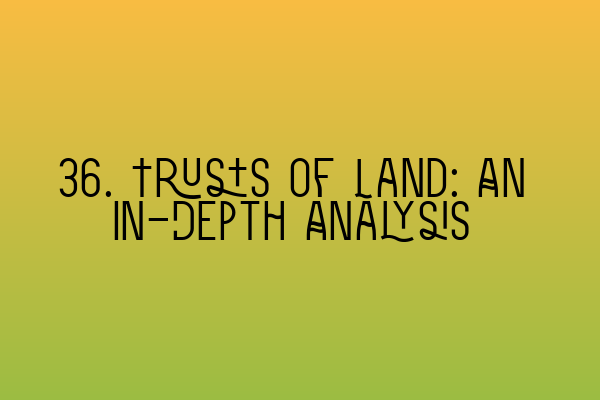36. Trusts of Land: An In-Depth Analysis
Welcome to another insightful article from SQE Property Law & Land Law! In this post, we will be taking an in-depth look at Trusts of Land, providing you with a comprehensive understanding of this important legal concept. Whether you are a solicitor, a law student preparing for the SQE exams, or simply someone wanting to expand your knowledge, this article is for you.
What is a Trust of Land?
A Trust of Land refers to a legal arrangement where property is held by one party (the trustee) for the benefit of another party (the beneficiary). It is a fundamental aspect of property law that allows for the equitable distribution of assets.
Trusts of Land can arise in various situations, such as joint ownership of property, family property arrangements, or investment schemes. Regardless of the scenario, understanding the principles and rules surrounding Trusts of Land is essential for anyone dealing with property transactions or disputes.
Key Features of Trusts of Land
There are several key features that characterize Trusts of Land:
- Trustee’s obligations: The trustee has a fiduciary duty to manage the property in the best interests of the beneficiaries. This duty includes maintaining and preserving the property, making reasonable decisions, and acting impartially.
- Beneficiary’s rights: The beneficiaries have enforceable rights to the trust property, including the right to occupy, use, or benefit from it. These rights are protected by law and can be enforced through the courts.
- Trustee’s powers: The trustee may have certain powers conferred upon them, such as the power to sell or mortgage the property, subject to any restrictions or conditions set out in the trust deed.
- Trust documentation: Trusts of Land are typically created through a formal written trust deed or by operation of law. The trust deed outlines the terms and conditions of the trust, including the identity of the trustee, beneficiaries, and the purpose of the trust.
These key features serve as the foundation for understanding the complexities and intricacies of Trusts of Land. Knowing how these features interact and impact property rights is crucial for legal professionals and anyone involved in property transactions.
Types of Trusts of Land
Trusts of Land can take on various forms, depending on the specific circumstances and arrangements between the parties involved. Some common types of Trusts of Land include:
- Bare Trusts: In a bare trust, the trustee holds the property for the beneficiary, who has an absolute right to the trust property. The trustee’s role is simply to hold legal title and has no discretion or power over the trust property.
- Resulting Trusts: Resulting trusts arise when property is transferred to someone, but it is clear that they were not intended to be the beneficial owner. In such cases, the law recognizes a trust in favor of the party who provided the funds or has a legitimate claim to the property.
- Constructive Trusts: Constructive trusts are equitable remedies imposed by the courts to prevent unconscionable conduct or protect the rights of the claimant. They are often used in cases where there is a breach of trust or unfair enrichment.
These are just a few examples of the many types of Trusts of Land that can arise in different legal situations. Each type of trust has its own set of principles and requirements, making it crucial to consult with a professional when dealing with these matters.
Legal Framework and Case Law
The legal framework for Trusts of Land is primarily governed by the Trusts of Land and Appointment of Trustees Act 1996 (TOLATA). This statute provides a comprehensive set of rules and principles that apply to Trusts of Land across England and Wales.
In addition to TOLATA, an extensive body of case law has developed over the years, shaping the interpretation and application of Trusts of Land. Landmark cases such as Stack v Dowden (2007) and Jones v Kernott (2011) have addressed important issues related to beneficial ownership, rights of occupation, and division of trust property.
Understanding the legal framework and staying updated with relevant case law is vital when dealing with Trusts of Land. Legal professionals must be able to navigate through and apply these principles to provide effective advice and representation to their clients.
Conclusion
Trusts of Land play a crucial role in property law, ensuring equitable distribution and protection of property rights. From the key features and types of Trusts of Land to the legal framework and case law, this article has provided you with an in-depth analysis of this important legal concept.
If you are preparing for the SQE exams or seeking expert guidance in property law, remember to check out our related articles:
- SQE 1 Practice Exam Questions
- SQE 1 Practice Mocks FLK1 FLK2
- SQE 2 Preparation Courses
- SQE 1 Preparation Courses
- SRA SQE Exam Dates
At SQE Property Law & Land Law, we are dedicated to providing top-notch legal education and resources. Stay tuned for more informative articles and feel free to reach out to us for all your property law needs.
